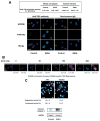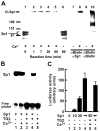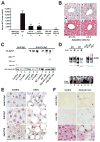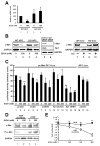Role of transglutaminase 2 in liver injury via cross-linking and silencing of transcription factor Sp1
- PMID: 19208340
- PMCID: PMC4960455
- DOI: 10.1053/j.gastro.2009.01.007
Role of transglutaminase 2 in liver injury via cross-linking and silencing of transcription factor Sp1
Abstract
Background & aims: Despite high morbidity and mortality of alcoholic liver disease worldwide, the molecular mechanisms underlying alcohol-induced liver cell death are not fully understood. Transglutaminase 2 (TG2) is a cross-linking enzyme implicated in apoptosis. TG2 levels and activity are increased in association with various types of liver injury. However, how TG2 induces hepatic apoptosis is not known.
Methods: Human hepatic cells or primary hepatocytes from rats or TG2+/+ and TG2-/- mice were treated with ethanol. Mice were administered anti-Fas antibody or alcohol. Liver sections were prepared from patients with alcoholic steatohepatitis. Changes in TG2 levels, Sp1 cross-linking and its activities, expression of hepatocyte growth factor receptor, c-Met, and hepatic apoptosis were measured.
Results: Ethanol induced apoptosis in hepatic cells, enhanced activity and nuclear accumulation of TG2 as well as accumulation of cross-linked and inactivated Sp1, and reduced expression of the Sp1-responsive gene, c-Met. These effects were rescued by TG2 knockdown, restoration of functional Sp1, or addition of hepatocyte growth factor, whereas apoptosis was reproduced by Sp1 knockdown or TG2 overexpression. Compared with TG2+/+ mice, TG2-/- mice showed markedly reduced hepatocyte apoptosis and Sp1 cross-linking following ethanol or anti-Fas treatment. Treatment of TG2+/+ mice with the TG2 inhibitors putrescine or cystamine blocked anti-Fas-induced hepatic apoptosis and Sp1 silencing. Moreover, enhanced expression of cross-linked Sp1 and TG2 was evident in hepatocyte nuclei of patients with alcoholic steatohepatitis.
Conclusions: TG2 induces hepatocyte apoptosis via Sp1 cross-linking and inactivation, with resultant inhibition of the expression of c-Met required for hepatic cell viability.
Conflict of interest statement
Conflicts of interest
The authors disclose no conflicts.
Figures






Comment in
-
Transglutaminase cross-links Sp1-mediated transcription to ethanol-induced liver injury.Gastroenterology. 2009 May;136(5):1502-5. doi: 10.1053/j.gastro.2009.03.021. Epub 2009 Mar 21. Gastroenterology. 2009. PMID: 19318103 No abstract available.
Similar articles
-
Induction of cross-linking and silencing of Sp1 by transglutaminase during liver injury in ASH and NASH via different ER stress pathways.Dig Dis. 2010;28(6):715-21. doi: 10.1159/000324278. Epub 2011 Apr 27. Dig Dis. 2010. PMID: 21525755 Review.
-
Recent advances in understanding the roles of transglutaminase 2 in alcoholic steatohepatitis.Cell Biol Int. 2010 Feb 22;34(3):325-34. doi: 10.1042/CBI20090130. Cell Biol Int. 2010. PMID: 20192918 Review.
-
Free fatty acids induce transglutaminase 2-dependent apoptosis in hepatocytes via ER stress-stimulated PERK pathways.J Cell Physiol. 2012 Mar;227(3):1130-7. doi: 10.1002/jcp.22833. J Cell Physiol. 2012. PMID: 21567402
-
Regulation of transglutaminase-mediated hepatic cell death in alcoholic steatohepatitis and non-alcoholic steatohepatitis.J Gastroenterol Hepatol. 2012 Mar;27 Suppl 2:52-7. doi: 10.1111/j.1440-1746.2011.07009.x. J Gastroenterol Hepatol. 2012. PMID: 22320917
-
Dual induction of caspase 3- and transglutaminase-dependent apoptosis by acyclic retinoid in hepatocellular carcinoma cells.Mol Cancer. 2011 Jan 9;10:4. doi: 10.1186/1476-4598-10-4. Mol Cancer. 2011. PMID: 21214951 Free PMC article.
Cited by
-
Tissue Transglutaminase-Regulated Transformed Growth Factor-β1 in the Parasite Links Schistosoma japonicum Infection with Liver Fibrosis.Mediators Inflamm. 2015;2015:659378. doi: 10.1155/2015/659378. Epub 2015 Jun 23. Mediators Inflamm. 2015. PMID: 26199461 Free PMC article.
-
A guide to selecting high-performing antibodies for Protein-glutamine gamma-glutamyltransferase 2 (TGM2) for use in western blot, immunoprecipitation and immunofluorescence.F1000Res. 2024 Jul 30;13:481. doi: 10.12688/f1000research.150684.2. eCollection 2024. F1000Res. 2024. PMID: 39220380 Free PMC article.
-
Inhibiting Transglutaminase 2 Mediates Kidney Fibrosis via Anti-Apoptosis.Biomedicines. 2022 Jun 7;10(6):1345. doi: 10.3390/biomedicines10061345. Biomedicines. 2022. PMID: 35740367 Free PMC article.
-
The Motility and Mesenchymal Features of Breast Cancer Cells Correlate with the Levels and Intracellular Localization of Transglutaminase Type 2.Cells. 2021 Nov 6;10(11):3059. doi: 10.3390/cells10113059. Cells. 2021. PMID: 34831282 Free PMC article.
-
HCV NS3 protease enhances liver fibrosis via binding to and activating TGF-β type I receptor.Sci Rep. 2013 Nov 22;3:3243. doi: 10.1038/srep03243. Sci Rep. 2013. PMID: 24263861 Free PMC article.
References
-
- Ribeiro PS, Cortez-Pinto H, Solá S, et al. Hepatocyte apoptosis, expression of death receptors, and activation of NF-κB in the liver of nonalcoholic and alcoholic steatohepatitis patients. Am J Gastroenterol. 2004;99:1708–1717. - PubMed
-
- Lorand L, Graham RM. Transglutaminases: cross-linking enzymes with pleiotropic functions. Nat Rev Mol Cell Biol. 2003;4:140–156. - PubMed
-
- Fésüs L, Piacentini M. Transglutaminase 2: an enigmatic enzyme with diverse functions. Trends Biochem Sci. 2002;27:534–539. - PubMed
-
- Mirza A, Liu SL, Frizell E, et al. A role for tissue transglutaminase in hepatic injury and fibrogenesis, and its regulation by NF-kB. Am J Physiol. 1997;272:G281–G288. - PubMed
Publication types
MeSH terms
Substances
Associated data
- Actions
Grants and funding
LinkOut - more resources
Full Text Sources
Medical
Molecular Biology Databases
Research Materials
Miscellaneous

